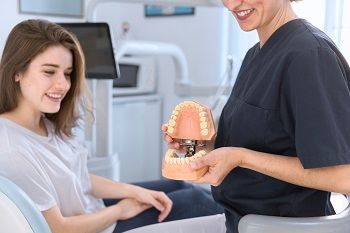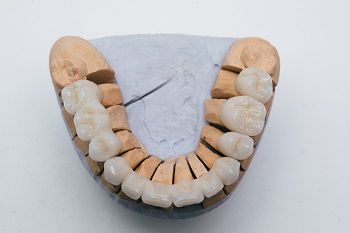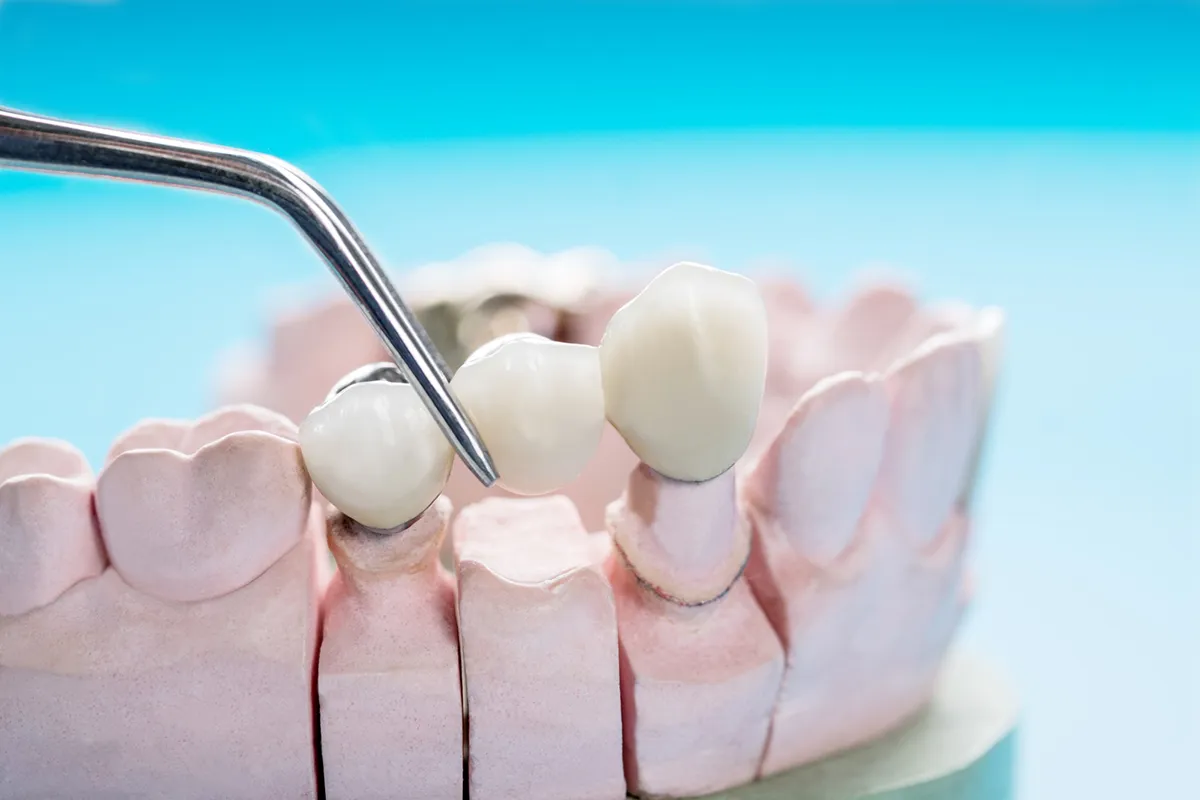The loss of one or more teeth goes beyond the visual impact on a smile, with broader consequences. Chewing becomes challenging, speech may be affected, and neighboring teeth may shift, leading to potential oral health issues.
Dental bridges step in as an excellent solution, seamlessly bridging the gaps created by missing teeth. These bridges are custom-made prosthetic devices, meticulously crafted to resemble the natural appearance of the teeth and provide stability and functionality to the dental arch.
With their ingenious design and construction, these remarkable devices offer a reliable solution to replace missing teeth. Dental bridges are customized to blend seamlessly with the natural teeth, providing a natural-looking and functional replacement. They enhance the visual appearance and allow people to enjoy a more varied diet and speak confidently.
An in-depth understanding of dental bridges and how they work will help you make informed decisions about your oral health and explore the possibilities of achieving a complete and beautiful smile. In this article, we will explore the world of dental bridges and uncover the fascinating ways they work their magic to transform smiles and improve oral well-being. So, let’s get started.
“Dental bridges are highly successful in replacing missing teeth. On average, they have a success rate of up to 95%. Studies suggest they typically remain functional for 10 to 15 years or even longer with the right care and maintenance”.
What Are Dental Bridges?
Dental bridges replace missing teeth and help restore your smile and ability to chew correctly. These special dental devices are known as “bridges” because they fill the space created by one or more missing teeth. Artificial teeth, known as pontics, are integral to dental bridges. These pontics resemble natural teeth in appearance and functionality. Providing seamless integration, dental crowns or implants support these pontics.
Dental bridges rely on the attachment of dental crowns to neighboring natural teeth, while implants are surgically inserted into the jawbone to provide support. To understand dental bridges comprehensively, you should familiarize yourself with their two essential components, i.e., pontics and abutments.
- The artificial teeth that replace missing teeth in a dental bridge are known as pontics. These pontics undergo careful design to match your natural teeth’ color, shape, and size, resulting in a seamless and natural appearance.

- In contrast, abutments play a vital role in supporting dental bridges. They can be either natural teeth or dental implants located adjacent to the gap caused by the missing teeth. To prepare the abutment teeth, a small portion of enamel is removed to create space for the dental bridge. Once designed, the abutment teeth fit with dental crowns or metal frameworks. These components provide stability and support to the pontics, securely holding the dental bridge.
The careful construction and placement of pontics and abutments ensure dental bridges’ strength, stability, and proper functionality, allowing you to eat, speak, and smile confidently.
By combining a comprehensive understanding of dental bridges with the expertise of a skilled dentist, you can embark on a transformative journey toward reclaiming your oral health, restoring your smile, and enjoying the benefits of a complete set of teeth. Remember to consult your dentist for personalized advice and guidance regarding dental bridges and their suitability for your dental needs.
Purpose of Dental Bridges
The primary purpose of dental bridges is to address the vacant spaces that result from missing teeth. When teeth are lost, it not only affects the aesthetics of your smile but can also lead to various oral health problems. Dental bridges address these issues by:
- Restoring functionality: Missing teeth can make it difficult to bite and chew properly, impacting your ability to eat a balanced diet. Dental bridges provide a stable biting surface, enabling you to enjoy a broader range of foods and maintain proper nutrition.
- Preventing teeth shifting: When there are gaps between teeth, the surrounding teeth may shift and tilt into the empty spaces, causing misalignment and bite problems. Dental bridges fill these gaps, preventing adjacent teeth from moving and preserving your bite’s natural alignment.
- Restoring speech: Teeth play a crucial role in forming certain sounds when speaking. Missing teeth can affect your ability to articulate words properly, leading to speech difficulties. Dental bridges help restore your speech clarity by replacing the missing teeth.
Types of Dental Bridges: Quick Overview
- Traditional bridges: Traditional bridges consist of one or more points held in place by dental crowns on the neighboring natural teeth. They are the most used type of dental bridge.
- Cantilever bridges: Cantilever bridges resemble traditional bridges but rely on a dental crown for support on just one side of the gap. Dentists use them in cases where there is only one adjacent natural tooth to the missing tooth.

- Maryland bridges: Maryland bridges, also known as resin-bonded bridges, are often used for replacing missing front teeth, where the forces exerted during chewing are relatively light compared to the back teeth.
- Implant-supported bridges: Implant-supported bridges rely on dental implants to provide support. These bridges are renowned for their stability and durability.
How Do Dental Bridges Work?
A dental bridge operates by utilizing dental crowns that cover the exposed portion of teeth to connect the teeth on both sides of a gap caused by missing teeth. It relies on the adjacent teeth for support and replaces the lost tooth’s chewing surface.
Regardless of its number of units, the bridge is a single piece of metal, porcelain, or a combination of both. For example, the three “teeth” are interconnected in a three-unit bridge. The crowns work as retainer teeth, while the attached pontic rests on the gums in the space left by the missing tooth.
The effectiveness of a bridge depends on the neighboring teeth’s ability to provide sufficient support for the additional chewing force exerted by the pontic. It serves the purpose of replacing the lost tooth and its chewing surface.
However, it’s important to note that a dental bridge does not replace the root of the missing tooth. As a result, the support for a dental bridge primarily relies on the adjacent retainer teeth, as it bears the load and provides stability.
By connecting the retainer teeth and placing the pontic over the gap, a dental bridge helps reinstate the ability to chew and bite properly. It fills the space left by the missing tooth, enabling efficient chewing of food.
However, it’s essential to remember that the lack of a root means the bridge may not have the same level of support and stability as a natural tooth. Therefore, maintaining good oral hygiene and regular dental check-ups are crucial to ensure the long-term success of a dental bridge.
Concluding Thoughts
Dental bridges not only restore the functionality of our teeth, allowing us to chew and bite properly, but they also help maintain proper tooth alignment. Dental bridges contribute to a balanced bite and a healthy oral environment by preventing adjacent teeth from shifting or tilting.
Beyond their functional benefits, dental bridges work their magic by enhancing the aesthetics of our smiles. These prosthetic devices blend seamlessly with our natural teeth, providing a complete and natural-looking set of teeth. With dental bridges, we can regain our confidence, smiling freely and without hesitation.
Contact your Pinole dentist, Azadeh Hosseini, DDS, or Ghazal Hosseini, DDS, at Top Pinole Dental to learn about Dental Bridges.
Resource
Dental Bridge Vs Partial Denture, Advantage And Disadvantages
*This media/content or any other on this website does not prescribe, recommend, or prevent any treatment or procedure. Therefore, we highly recommend that you get the advice of a qualified dentist or other medical practitioners regarding your specific dental condition*
1500 Tara Hills Dr., Suite 104A, Pinole, CA 94564
Monday – Saturday 8:00 AM to 5:00 PM
